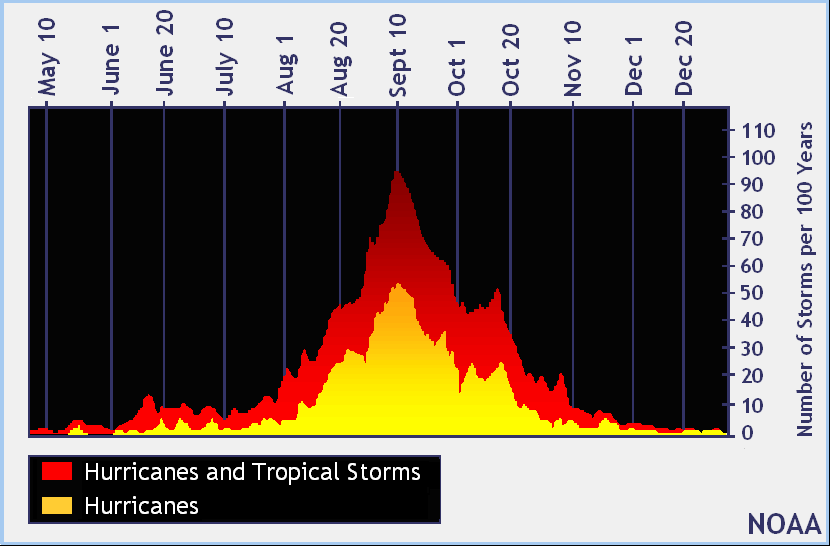Number of Tropical Cyclones per 100 Years

The official hurricane season for the Atlantic Basin (the Atlantic Ocean, the Caribbean Sea, and the Gulf of Mexico) is from 1 June to 30 November. As seen in the graph above, the peak of the season is from mid-August to late October. However, deadly hurricanes can occur anytime in the hurricane season.
From Wunderblog, Sept. 9:
...Midpoint review: A fairly active, not-too-destructive Atlantic season...MORE
Now that we’re at the climatological midpoint of the Atlantic hurricane season (September 10 or 11, depending upon which statistics one uses), it’s a good time to review how this season is shaping up. We can compare this season to what one might expect from climatology based on data compiled by Phil Klotzbach (Colorado State University). As a climatological benchmark, Klotzbach uses the 30-year period from 1981 to 2010, which is almost evenly split between the pre-1995 inactive period and the post-1995 active period in the Atlantic. Here’s where we stand as of September 9 relative to the amount of activity that an average season would have produced by now:
8 named storms (typical by 9/9 is 6.5)This season is running a bit below average on ACE, as well as the number of hurricane days and major-hurricane days (not shown here). We are considerably above average on the number of named storms and hurricanes. If we continued the rest of the season at exactly this pace, we'd end up with 16 named storms, 8 hurricanes, and 2 majors. That would line up pretty well with the consensus of the various forecast groups as summarized by Phil Klotzbach. Here again, we're running ahead of the consensus on the number of named storms and hurricanes, but a bit under expectation on the amount of ACE. The four tropical storms this year were all quite weak (Bonnie, Colin, Danielle, Fiona).
4 hurricanes (typical by 9/9 is 2.7)
1 major hurricane (typical by 9/9 is 1.2)
40.7 ACE, or accumulated cyclone energy (typical by 9/9 is 46.2)
About 60% of the entire season’s ACE thus far--more than every other tropical cyclone combined--was generated by long-lived Hurricane Gaston, which stayed far out to sea. The most destructive Atlantic system of the year thus far, Hurricane Hermine, produced total economic damages that could approach $1 billion. We’ve had one quite deadly storm this year: Hurricane Earl, which hit Belize as a Category 1 storm on August 4, then made a second landfall on Mexico’s Bay of Campeche coast on August 6. Earl killed 67 people and left 12 others missing; 57 of the fatalities were in Mexico, due to flooding and mudslides.
NOAA: La Niña a no-show
On Thursday, NOAA cancelled its La Niña Watch, as the atmosphere has failed to respond to sea-surface temperatures in the borderline La Niña range. If La Niña indeed fails to materialize, then the rest of the Atlantic season may end up less active than predicted by some of the higher-end outlooks that anticipated La Niña’s emergence.
We'll have an update on Saturday afternoon.